Computer simulation of scavenging by hominins and giant hyenas in the late Early Pleistocene
- PMID: 37770511
- PMCID: PMC10539305
- DOI: 10.1038/s41598-023-39776-1
Computer simulation of scavenging by hominins and giant hyenas in the late Early Pleistocene
Abstract
Consumption of animal-sourced food is an important factor in broadening the diet of early hominins, promoting brain and body growth, and increasing behavioural complexity. However, whether early hominins obtained animal food by scavenging or hunting large mammals remains debated. Sabre-toothed felids have been proposed to facilitate the expansion of early Homo out of Africa into Europe 1.4-0.8 Ma by creating a niche for scavengers in Eurasia as the carcasses abandoned by these felids still contained abundant edible resources. In contrast, it has been argued that the niche for a large scavenger was already occupied in Eurasia by the giant hyena, preventing hominins from utilising this resource. This study shows that sabre-toothed felids generated carcasses rich in edible resources and that hominins were capable of competing with giant hyenas for this resource. The simulation experiments showed that maintaining an optimum group size is essential for the success of the hominin scavenging strategy. Early hominins could outcompete giant hyenas only if they could successfully dispute carcasses with them. Thus, in the presence of a strong competitor, passive scavenging is essentially the same as confrontational scavenging.
© 2023. Springer Nature Limited.
Conflict of interest statement
The authors declare no competing interests.
Figures


Similar articles
-
Computer vision supports primary access to meat by early Homo 1.84 million years ago.PeerJ. 2022 Oct 18;10:e14148. doi: 10.7717/peerj.14148. eCollection 2022. PeerJ. 2022. PMID: 36275476 Free PMC article.
-
Early Pleistocene hominin subsistence behaviors in South Africa: Evidence from the hominin-bearing deposit of Cooper's D (Bloubank Valley, South Africa).J Hum Evol. 2022 Jan;162:103116. doi: 10.1016/j.jhevol.2021.103116. Epub 2021 Dec 13. J Hum Evol. 2022. PMID: 34915399
-
The effects of carnivore diversity on scavenging opportunities and hominin range expansion during Out of Africa I.J Hum Evol. 2025 Jun;203:103680. doi: 10.1016/j.jhevol.2025.103680. Epub 2025 Apr 28. J Hum Evol. 2025. PMID: 40300461
-
The zooarchaeology and paleoecology of early hominin scavenging.Evol Anthropol. 2020 Mar;29(2):68-82. doi: 10.1002/evan.21824. Epub 2020 Feb 28. Evol Anthropol. 2020. PMID: 32108400 Review.
-
Brain ontogeny and life history in Pleistocene hominins.Philos Trans R Soc Lond B Biol Sci. 2015 Mar 5;370(1663):20140062. doi: 10.1098/rstb.2014.0062. Philos Trans R Soc Lond B Biol Sci. 2015. PMID: 25602066 Free PMC article. Review.
Cited by
-
Human Digestive Physiology and Evolutionary Diet: A Metabolomic Perspective on Carnivorous and Scavenger Adaptations.Metabolites. 2025 Jul 4;15(7):453. doi: 10.3390/metabo15070453. Metabolites. 2025. PMID: 40710552 Free PMC article. Review.
References
-
- Palmqvist P, et al. Insights on the early pleistocene hominin population of the Guadix-Baza depression (SE Spain) and a review on the ecology of the first peopling of Europe. Front. Ecol. Evol. 2022;10:881651. doi: 10.3389/fevo.2022.881651. - DOI
-
- Iannucci A, Mecozzi B, Sardella R, Iurino DA. The extinction of the giant hyena Pachycrocuta brevirostris and a reappraisal of the Epivillafranchian and Galerian Hyaenidae in Europe: Faunal turnover during the early-middle Pleistocene transition. Quat. Sci. Rev. 2021;272:107240. doi: 10.1016/j.quascirev.2021.107240. - DOI
Publication types
MeSH terms
Associated data
LinkOut - more resources
Full Text Sources

